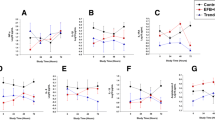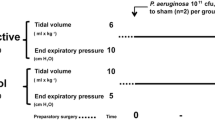Abstract
Objective: To determine the effect of peak inspiratory pressure (PIP) and positive end-expiratory pressure (PEEP) on the development of bacteremia with Klebsiella pneumoniae after mechanical ventilation of intratracheally inoculated rats.
Design: Prospective, randomized, animal study.
Setting: Experimental intensive care unit of a University.
Subjects: Eighty male Sprague Daw-ley rats.
Interventions: Intratracheal inoculation with 100 µl of saline containing 3.5−5.0×105 colony forming units (CFUs) K. pneumoniae/ml. Pressure-controlled ventilation (frequency 30 bpm; I/E ratio=1:2; FIO2=1.0) for 180 min at the following settings (PIP/PEEP in cmH2O): 13/3 (n=16); 13/0 (n=16); 30/10 (n=16) and 30/0 (n=16), starting 22 h after inoculation. Arterial blood samples were obtained and cultured before and 180 min after mechanical ventilation and immediately before sacrifice in two groups of non-ventilated control animals (n=8 per group). After sacrifice, the lungs were homogenized to determine the number of CFUs K. pneumoniae.
Measurements and results: The number of CFUs recovered from the lungs was comparable in all experimental groups. After 180 min, 11 animals had positive blood cultures for K. pneumoniae in group 30/0, whereas only 2,0 and 2 animals were positive in 13/3,13/0 and 30/10, respectively (p<0.05 group 30/0 versus all other groups).
Conclusions: These data show that 3 h of mechanical ventilation with a PIP of 30 cmH2O without PEEP in rats promotes bacteremia with K. pneumoniae. The use of 10 cmH2O PEEP at such PIP reduces ventilation-induced K. pneumoniae bacteremia.
Similar content being viewed by others
References
Montgomery AB, Stager MA, Carrico CJ, Hudson LD (1985) Causes of mortality in patients with the adult respiratory distress syndrome. Am Rev Respir Dis 132: 485–489
Swank GM, Deitch EA (1996) Role of the gut in multiple organ failure: Bacterial translocation and permeability changes. World J Surg 20: 411–417
Schlag G, Redl H (1996) Mediators of injury and inflammation. World J Surg 20: 406–410
Tremblay L, Valenza F, Ribeiro SP, Jingfang L, Slutsky AS (1997) Injurious ventilatory strategies increase cytokines and c-fos m-RNA expression in an isolated rat lung model. J Clin Invest 99: 944–952
Von Bethmann AN, Brasch F, Müller K, Wendel A, Uhlig S (1996) Prolonged hyperventilation is required for release of tumor necrosis factor a but not IL-6. Appl Cardiopulm Pathophysiol 6: 171–177
Van ’t Veen A, Mouton JW, Gommers D, Lachmann B (1996) Pulmonary surfactant as vehicle for intratracheally instilled tobramycin in mice infected with Klebsiella pneumoniae. Br J Pharmacol 119:1145–1148
Roosendaal R, Bakker IAJM, Van den Berghe-van Raffe M, Michel MF (1986) Continuous versus intermittent administration of ceftazidime in experimental Klebsiella pneumoniae pneumonia in normal and leukopenic rats. Antimicrob Agents Chemother 30: 403–408
Webb HH, Tierney DF (1974) Experimental pulmonary edema due to intermittent positive pressure ventilation with high inflation pressures. Protection by positive end-expiratory pressure. Am Rev Respir Dis 110: 556–565
Dreyfuss D, Basset G, Soler P, Saumon G (1985) Intermittent positive-pressure hyperventilation with high inflation pressures produces pulmonary microvascular injury in rats. Am Rev Respir Dis 132: 880–884
Dreyfuss D, Soler P, Basset G, Saumon G (1988) Intermittent positive pressure pulmonary edema: respective effects of high airway pressure, high tidal volume, and positive end-expiratory pressure. Am Rev Respir Dis 137:1159–1164
LaForce FM, Mullane JF, Boehme RF, Kelly WJ, Huber GL (1973) The effect of pulmonary edema on antibacterial defenses of the lung. J Lab Clin Med 82: 634–648
Brough-Holub E, Toews GB, van Iwaarden F, Strieter RM, Kunkel SL, Paine R III, Standiford TJ (1997) Alveolar macrophages are required for protective pulmonary defenses in murine Klebsiella Pneumonia: Elimination of alveolar macrophages increases neutrophil recruitment but decreases bacterial clearance and survival. Infect Immun 65:1139–1146
Lachmann B, Eijking EP, So KL, Gommers D (1994) In vivo evaluation of the inhibitory capacity of human plasma on exogenous surfactant function. Intensive Care Med 20: 6–11
Van ’t Veen, Gommers D, Lachmann B (1997) Rationale for surfactant therapy in pneumonia. In: Vincent JL (ed) Year book of Intensive Care and Emergency Medicine. Springer, Berlin Heidelberg, pp 638–653
Huber JL, Johanson WG, La Force FM (1977) Experimental models and pulmonary antimicrobial defenses. In: Brian JD, Proctor DF, Reid L (eds) Respiratory defense mechanisms. Dekker, New York, pp 983–1022
Gøthgen IH, Berthelsen PG, Rasmussen JP, Jacobsen E (1993) Ventilation in ARDS and asthma: the optimal blood gas values. Scand J Clin Lab Invest Suppl 214: 67–73
Seidenfeld JJ, Mullins RC, Fowler SR, Johanson WG (1986) Bacterial infection and acute lung injury in hamsters. Am Rev Respir Dis 134: 22–26
Tilson MD, Bunke MC, Walker Smith GJ, Katz J, Cronau L, Barash PG, Baue AE (1977) Quantitative bacteriology and pathology of the lung in experimental Pseudomonas pneumonia treated with positive end-expiratory pressure (PEEP). Surgery 82:133–140
Johanson WG, Higuchi JH, Woods DE, Gomez P, Coalson JJ (1985) Dissemination of Pseudomonas aeruginosa during lung infection in hamsters. Role of oxygen-induced lung injury. Am Rev Respir Dis 132: 358–361
Tremblay LN, Slutsky AS (1996) The role of pressure and volume in ventilator induced lung injury. Appl Cardiopulm Pathophysiol 6:179–190
Dreyfuss D, Saumon G (1993) Role of tidal volume, FRC, and end-inspiratory volume in the development of pulmonary edema following mechanical ventilation. Am Rev Respir Dis 148: 1194–1203
Taskar V, John J, Evander E, Roberston B, Jonson B (1997) Surfactant dysfunction makes lungs vulnerable to repetitive collapse and reexpansion. Am J respir Crit Care Med 155: 313–320
Brigham KL (1982) Mechanisms of lung injury. Clin Chest Med 3: 9–24
Tyler DC (1983) Positive end-expiratory pressure: A review. Crit Care Med 11: 300–308
Author information
Authors and Affiliations
Additional information
Supported by the International Foundation for Clinically Oriented Research (IFCOR).
Rights and permissions
About this article
Cite this article
Verbrugge, S.J.C., Šorm, V., van ’t Veen, A. et al. Lung overinflation without positive end-expiratory pressure promotes bacteremia after experimental Klebsiella pneumoniae inoculation. Intensive Care Med 24, 172–177 (1998). https://doi.org/10.1007/s001340050541
Received:
Accepted:
Issue Date:
DOI: https://doi.org/10.1007/s001340050541




